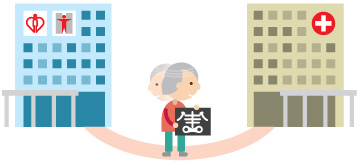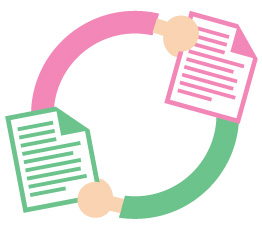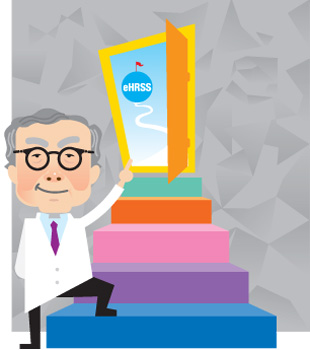.jpg) |
|
“The ultimate goal is for an individual to have a portable health record through the Electronic Health Record Sharing System (eHRSS), which can accompany him/her across different healthcare delivery systems, so as to enjoy continuity of care as well as appropriate, timely and safe treatment provided by different healthcare providers.”
|
Dr Raymond Yung,
Deputy Medical Superintendent,
Hong Kong Sanatorium & Hospital (HKSH)
|
|
|
| |
|
In Hong Kong, it is common for patients to move between private and public healthcare providers. Dr Yung said the major advantage of the eHRSS is the two-way data sharing across the public and private sectors, providing a channel for clinical communication which will help reduce errors, avoid repeated tests and improve patient safety.
|
 |
|
It is common for patients to move between private and public
healthcare providers |
|
|
|
| |
| “It used to be a one-way sharing under the Public-Private Interface–Electronic Patient Record Sharing Pilot Project, where private healthcare providers (HCPs) can access patient information kept by public hospitals,” he said. |
| |
|
“It is a major step forward now that public hospitals and clinics can also view patient records uploaded by private hospitals and practitioners,” he added. |
| |
| In the long run, Dr Yung believes that this can help build up life-long portable health records for patients, which can be retrieved and used throughout different healthcare services in both the public and private sectors. |
| |
| Data across Healthcare Sectors |
| |
| Dr Yung agreed that the eHRSS constitutes a platform where doctors can complement each other by sharing information necessary for making patient care decisions and referrals. “Appropriate care, timely treatment and improved care safety for patients are what we hope to achieve by having more information,” he said. |
| |
| “Information such as previous medical test results, drugs prescribed by other doctors and allergy history is important for us,” he added. |
| |
 |
| |
| Information sharing through the eHRSS, in Dr Yung’s opinion, also makes closer public-private collaboration possible. |
| |
“Some patients came to private hospitals for medical examinations. When their conditions necessitated surgeries and they preferred to have surgeries done in public hospitals, results of examinations conducted in private hospitals or clinics could be viewed directly by doctors in public hospitals,” he said.
“Data exchange is especially helpful in complex and highly difficult cases as well as for those patients who need shared care among different specialists,” he stressed.
|
 |
| Data exchange is especially helpful in complex and
highly difficult cases as well as for those patients who
need shared care among different specialists |
|
|
|
| |
| Recognising the benefits of the eHRSS, Dr Yung said the electronic health record (eHR) could serve as useful reference when making medical decisions, taking into account a number of factors including the degree of participation by the respective HCPs, the kinds of data they upload and the relevance of the data. |
| |
| HKSH’s eHR Experience |
| |
| The HKSH and all other private hospitals in Hong Kong were among the first batch of HCPs registered with the eHRSS when it was launched in March this year. Dr Yung said while patients welcome the eHRSS, efforts should be exerted to encourage more private doctors to participate in the system. |
| |
| “Private hospitals can serve as the catalyst to encourage participation from private doctors. For example, in the HKSH, we require all doctors to create a user account in the eHRSS. We are also urging the visiting practitioners to do the same,” he said, adding that ultimately the incentive may need to come from patients, driving the demand for eHR sharing as a key stakeholder group. |
| |
| As to the HKSH’s eHR experience, Dr Yung said digitisation of patient records has been the practice for several years. Having joined the eHRSS, the hospital is working to upload information onto the system. |
| |
| “Currently patient records of the HKSH’s out-patient department have been digitised, and work is in progress for our laboratory and imaging test reports to be compatible with the eHRSS.” |
| |
| “We are making preparation for the uploading of laboratory test reports to the eHRSS. Medication will follow as we are updating our pharmacy system. We are also looking forward to the uploading of imaging test reports, too,” said Dr Yung. |
| |
| “As for in-patients, there is still work to be done for full digitisation. Hand-writing, for instance, remains a major data-entry method in in-patient practices in private hospitals. This aside, we need to install the necessary software and hardware,” he explained. |
| |
| Dr Yung pointed out that given the operating environment of private hospitals, there are a few challenges in relation to eHR sharing that need to be overcome. |
| |
| Challenges in eHR Sharing
“To name one challenge, there are visiting doctors who have different styles of operational practices and eHR adoption may not be their preference. It requires, among other things, a change in culture and this cannot be done overnight,” he said.
Personal data privacy is another concern, according to Dr Yung. “Some patients in private hospitals would like a high degree of privacy and may not be willing to share any kind of records, even among different departments within the same hospital.”
|
 |
| eHR sharing is a long process and requires a change in culture. We have to do it step by step |
|
|
|
| |
| Further Development of eHR |
| |
| Turning to the question of future development, Dr Yung noted that there are quite a number of suggestions on how to take the eHR programme further. |
| |
| Among the proposals for Stage Two of the eHRSS development, Dr Yung most supported the inclusion of radiological images in the sharable data. |
| |
| “As the eHRSS continues to develop and more and more patients joining, it is important to strengthen public education. Patients should also be aware of aspects such as the scope of sharable data and the level of data sharing by doctors in order to avoid unrealistic expectations. Afterall, eHR sharing is a long process. We have to do it step by step,” Dr Yung remarked. |
| |
|
|

